child seat HONDA CIVIC HYBRID 2015 9.G Owners Manual
[x] Cancel search | Manufacturer: HONDA, Model Year: 2015, Model line: CIVIC HYBRID, Model: HONDA CIVIC HYBRID 2015 9.GPages: 377, PDF Size: 18.05 MB
Page 4 of 377

Contents
Child Safety P. 52Exhaust Gas Hazard P. 64Safety Labels P. 65
Opening and Closing the Trunk P. 114 Security System P. 117 Opening and Closing the Windows P. 119
Adjusting the Mirrors P. 132 Adjusting the Seats P. 134
Climate Control System P. 144
Audio Error Messages P. 184 General Information on the Audio System P. 188
When Driving P. 238 Braking P. 267Parking Your Vehicle P. 271
Accessories and Modifications P. 277
Maintenance Under the Hood P. 288 Replacing Light Bulbs P. 300
Checking and Maintaining Tires P. 308 12 Volt Battery P. 317 Remote Transmitter Care P. 318
Cleaning P. 320
Engine Does Not Start P. 341 Jump Starting P. 344 Shift Lever Does Not Move P. 346
Fuses P. 353 Emergency Towing P. 356
Devices that Emit Radio Waves P. 361 Reporting Safety Defects P. 362
Authorized Manuals P. 367 Customer Service Information P. 368
Quick Reference GuideP. 4
Safe DrivingP. 27
Instrument PanelP. 67
ControlsP. 101
FeaturesP. 147
DrivingP. 231
MaintenanceP. 279
Handling the UnexpectedP. 325
InformationP. 357
IndexP. 369
15 CIVIC IMA-31TR26300.book 3 ページ 2014年9月9日 火曜日 午後12時20分
Page 8 of 377
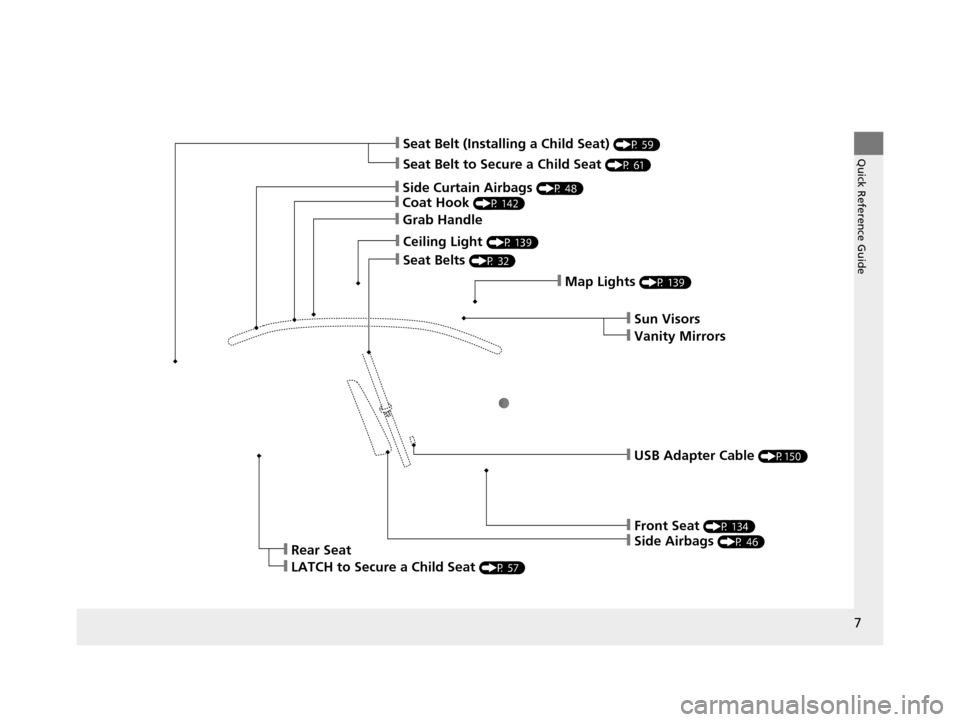
7
Quick Reference Guide
❙Side Curtain Airbags (P 48)
❙Coat Hook (P 142)
❙Grab Handle
❙Ceiling Light (P 139)
❙Seat Belts (P 32)
❙Map Lights (P 139)
❙Front Seat (P 134)
❙Side Airbags (P 46)
❙Seat Belt to Secure a Child Seat (P 61)
❙Seat Belt (Installing a Child Seat) (P 59)
❙Sun Visors
❙Vanity Mirrors
❙Rear Seat
❙LATCH to Secure a Child Seat (P 57)
❙USB Adapter Cable (P150)
15 CIVIC IMA-31TR26300.book 7 ページ 2014年9月9日 火曜日 午後12時20分
Page 15 of 377
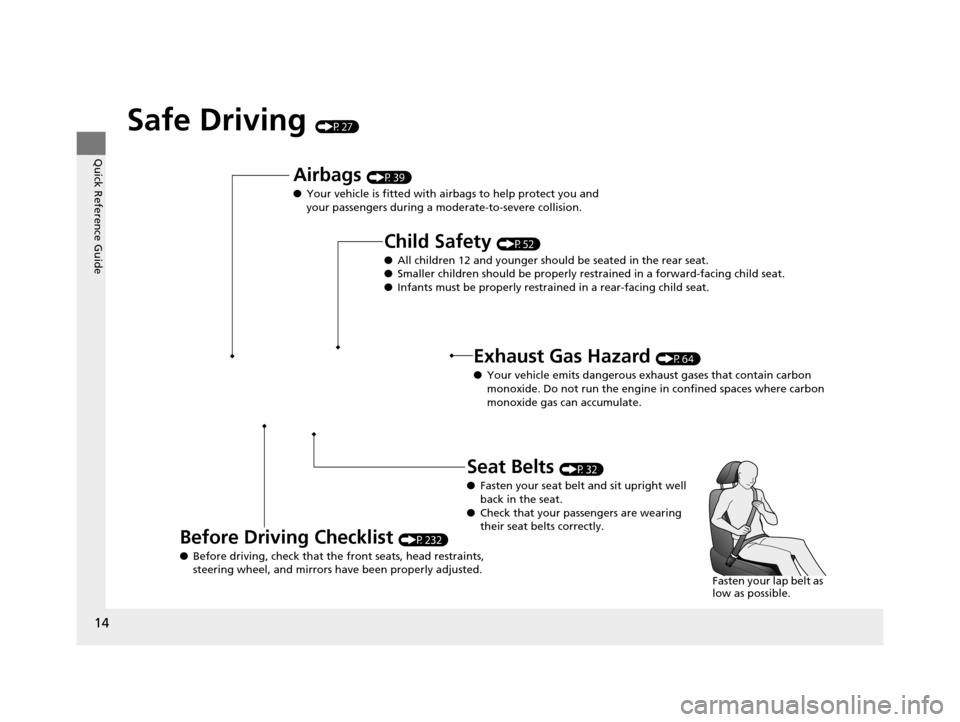
14
Quick Reference Guide
Safe Driving (P27)
Airbags (P39)
● Your vehicle is fitted with ai rbags to help protect you and
your passengers during a moderate-to-severe collision.
Child Safety (P52)
● All children 12 and younger should be seated in the rear seat.
● Smaller children should be properly restra ined in a forward-facing child seat.
● Infants must be properly restraine d in a rear-facing child seat.
Exhaust Gas Hazard (P64)
● Your vehicle emits dangerous exhaust gases that contain carbon
monoxide. Do not run the engine in confined spaces where carbon
monoxide gas can accumulate.
Before Driving Checklist (P232)
● Before driving, check that the front seats, head restraints,
steering wheel, and mirrors have been properly adjusted.
Seat Belts (P32)
● Fasten your seat belt and sit upright well
back in the seat.
● Check that your passengers are wearing
their seat belts correctly.
Fasten your lap belt as
low as possible.
15 CIVIC IMA-31TR26300.book 14 ページ 2014年9月9日 火曜日 午後12時20分
Page 28 of 377
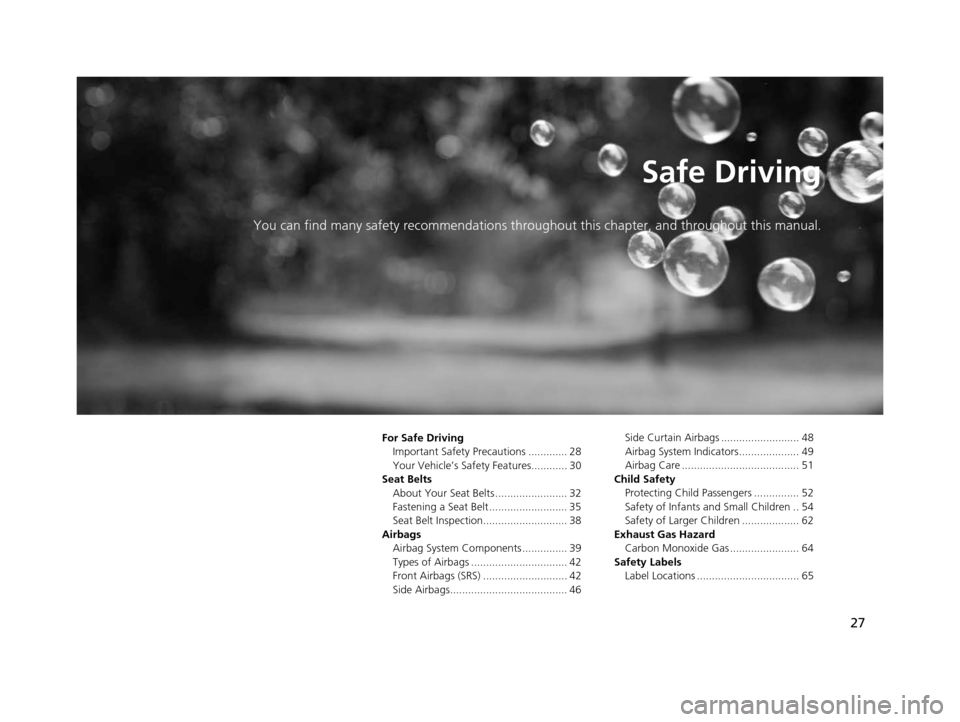
27
Safe Driving
You can find many safety recommendations throughout this chapter, and throughout this manual.
For Safe Driving
Important Safety Precautions ............. 28
Your Vehicle’s Safety Features............ 30
Seat Belts About Your Seat Belts ........................ 32
Fastening a Seat Belt .......................... 35
Seat Belt Inspection............................ 38
Airbags Airbag System Components ............... 39
Types of Airbags ................................ 42
Front Airbags (SRS) ............................ 42
Side Airbags....................................... 46 Side Curtain Airbags .......................... 48
Airbag System Indicators.................... 49
Airbag Care ....................................... 51
Child Safety Protecting Child Passengers ............... 52
Safety of Infants a nd Small Children .. 54
Safety of Larger Children ................... 62
Exhaust Gas Hazard Carbon Monoxide Gas ....................... 64
Safety Labels Label Locations .................................. 65
15 CIVIC IMA-31TR26300.book 27 ページ 2014年9月9日 火曜日 午後12時20分
Page 29 of 377
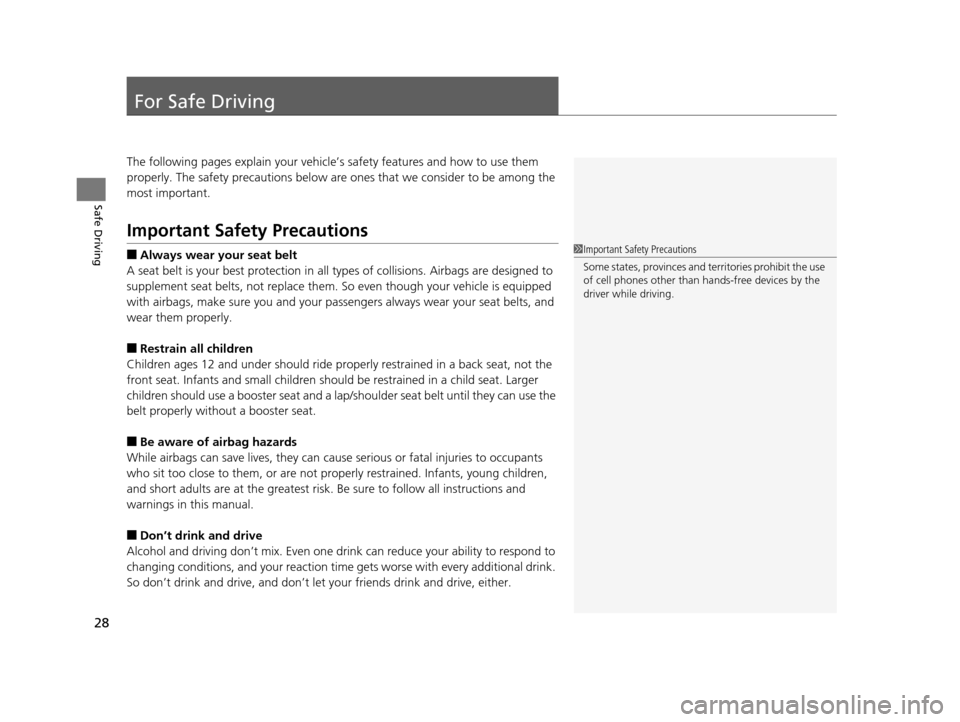
28
Safe Driving
For Safe Driving
The following pages explain your vehicle’s safety features and how to use them
properly. The safety precautions below are ones that we consider to be among the
most important.
Important Safety Precautions
■Always wear your seat belt
A seat belt is your best protection in all types of collisions. Airbags are designed to
supplement seat belts, not replace them. So even though your vehicle is equipped
with airbags, make sure you and your passengers always wear your seat belts, and
wear them properly.
■Restrain all children
Children ages 12 and under should ride prop erly restrained in a back seat, not the
front seat. Infants and small children should be restrained in a child seat. Larger
children should use a booster seat and a lap/shoulder seat belt until they can use the
belt properly without a booster seat.
■Be aware of airbag hazards
While airbags can save lives, they can cause serious or fatal injuries to occupants
who sit too close to them, or are not prop erly restrained. Infants, young children,
and short adults are at the greatest risk. Be sure to follow all instructions and
warnings in this manual.
■Don’t drink and drive
Alcohol and driving don’t mix. Even one dr ink can reduce your ability to respond to
changing conditions, and your reaction time gets worse with every additional drink.
So don’t drink and drive, and don’t let your friends drink and drive, either.
1Important Safety Precautions
Some states, provinces and territories prohibit the use
of cell phones other than hands-free devices by the
driver while driving.
15 CIVIC IMA-31TR26300.book 28 ページ 2014年9月9日 火曜日 午後12時20分
Page 32 of 377

31
uuFor Safe Driving uYour Vehicle’s Safety Features
Safe DrivingFor the safety of you and your passengers, make a habit of checking these items
each time before you drive.
• After everyone has entered the vehicle, be sure all doors are closed and locked.
Locking the doors helps prevent an occupant from being ejected and an outsider
from unexpectedly opening a door.
2 Locking/Unlocking the Doors from the Inside P. 110
•Adjust your seat to a position suitable for driving. Be sure the front seats are
adjusted as far to the rear as possible while allowing the driver to control the
vehicle. Sitting too close to a front airbag can result in serious or fatal injury in a
crash.
2 Adjusting the Seats P. 134
•Adjust head restraints to the proper position. Head restraints are most effective
when the center of the head restraint alig ns with the center of your head. Taller
persons should adjust their head restraint to the highest position.
2Adjusting the Head Restraints P. 136
•Always wear your seat belt, and make sure you wear it properly. Confirm that any
passengers are properly belted as well.
2 Fastening a Seat Belt P. 35
•Protect children by using seat belts or chil d seats according to a child’s age, height
and weight.
2 Child Safety P. 52
■Safety Checklist1Safety Checklist
If the door open indicator is on, a door is not
completely closed. Close all doors tightly until the
indicator goes off.
2 Door Open Indicator P. 72
15 CIVIC IMA-31TR26300.book 31 ページ 2014年9月9日 火曜日 午後12時20分
Page 33 of 377
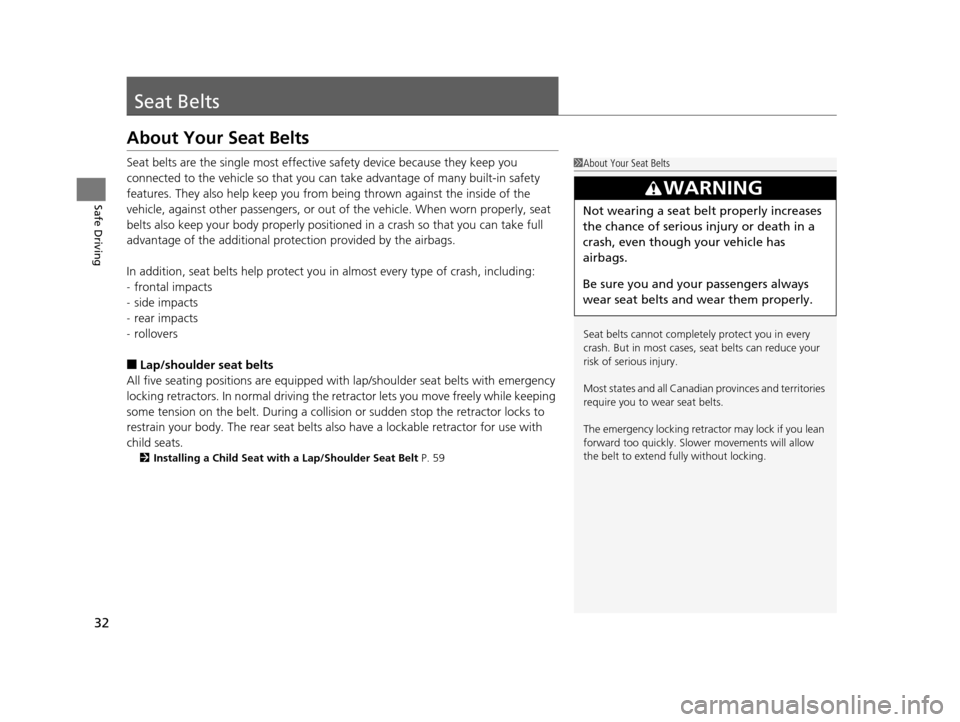
32
Safe Driving
Seat Belts
About Your Seat Belts
Seat belts are the single most effective safety device because they keep you
connected to the vehicle so that you can take advantage of many built-in safety
features. They also help keep you from being thrown against the inside of the
vehicle, against other passengers, or out of the vehicle. When worn properly, seat
belts also keep your body properly positi oned in a crash so that you can take full
advantage of the additional prot ection provided by the airbags.
In addition, seat belts help protect you in almost every type of crash, including:
- frontal impacts
- side impacts
- rear impacts
- rollovers
■Lap/shoulder seat belts
All five seating positions are equipped with lap/shoulder seat belts with emergency
locking retractors. In normal driving the retractor lets you move freely while keeping
some tension on the belt. During a collis ion or sudden stop the retractor locks to
restrain your body. The rear seat belts also have a lockable retractor for use with
child seats.
2 Installing a Child Seat with a Lap/Shoulder Seat Belt P. 59
1About Your Seat Belts
Seat belts cannot complete ly protect you in every
crash. But in most cases, seat belts can reduce your
risk of serious injury.
Most states and all Canadian provinces and territories
require you to wear seat belts.
The emergency locking retrac tor may lock if you lean
forward too quickly. Slower movements will allow
the belt to extend fu lly without locking.
3WARNING
Not wearing a seat belt properly increases
the chance of serious injury or death in a
crash, even though your vehicle has
airbags.
Be sure you and your passengers always
wear seat belts and wear them properly.
15 CIVIC IMA-31TR26300.book 32 ページ 2014年9月9日 火曜日 午後12時20分
Page 34 of 377
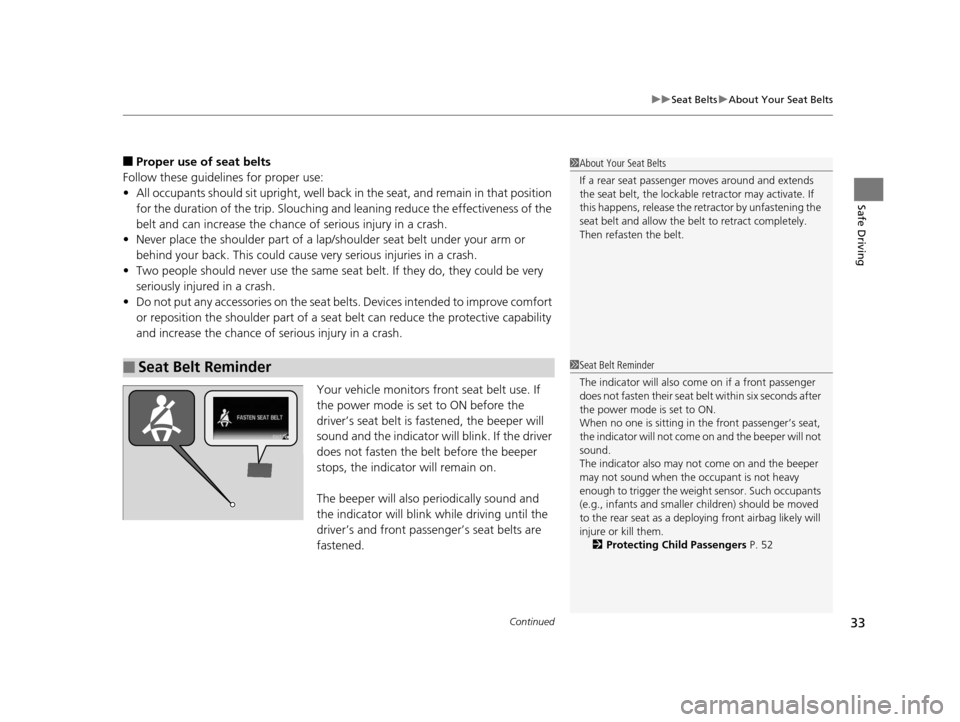
Continued33
uuSeat Belts uAbout Your Seat Belts
Safe Driving
■Proper use of seat belts
Follow these guidelines for proper use:
• All occupants should sit upright, well back in the seat, and remain in that position
for the duration of the trip. Slouching and leaning reduc e the effectiveness of the
belt and can increase the chance of serious injury in a crash.
• Never place the shoulder part of a lap/shoulder seat belt under your arm or
behind your back. This could cause very serious injuries in a crash.
• Two people should never use the same seat belt. If they do, they could be very
seriously injured in a crash.
• Do not put any accessories on the seat belt s. Devices intended to improve comfort
or reposition the shoulder part of a seat belt can reduce the protective capability
and increase the chance of serious injury in a crash.
Your vehicle monitors front seat belt use. If
the power mode is set to ON before the
driver’s seat belt is fastened, the beeper will
sound and the indicator will blink. If the driver
does not fasten the belt before the beeper
stops, the indicato r will remain on.
The beeper will also periodically sound and
the indicator will blink while driving until the
driver’s and front passenger’s seat belts are
fastened.
■Seat Belt Reminder
1 About Your Seat Belts
If a rear seat passenger moves around and extends
the seat belt, the lockable retractor may activate. If
this happens, release the retractor by unfastening the
seat belt and allow the belt to retract completely.
Then refasten the belt.
1 Seat Belt Reminder
The indicator will also co me on if a front passenger
does not fasten their seat belt within six seconds after
the power mode is set to ON.
When no one is sitting in th e front passenger’s seat,
the indicator will not come on and the beeper will not
sound.
The indicator also may no t come on and the beeper
may not sound when the occupant is not heavy
enough to trigger the weight sensor. Such occupants
(e.g., infants and smaller children) should be moved
to the rear seat as a deploying front airbag likely will
injure or kill them. 2 Protecting Child Passengers P. 52
15 CIVIC IMA-31TR26300.book 33 ページ 2014年9月9日 火曜日 午後12時20分
Page 38 of 377
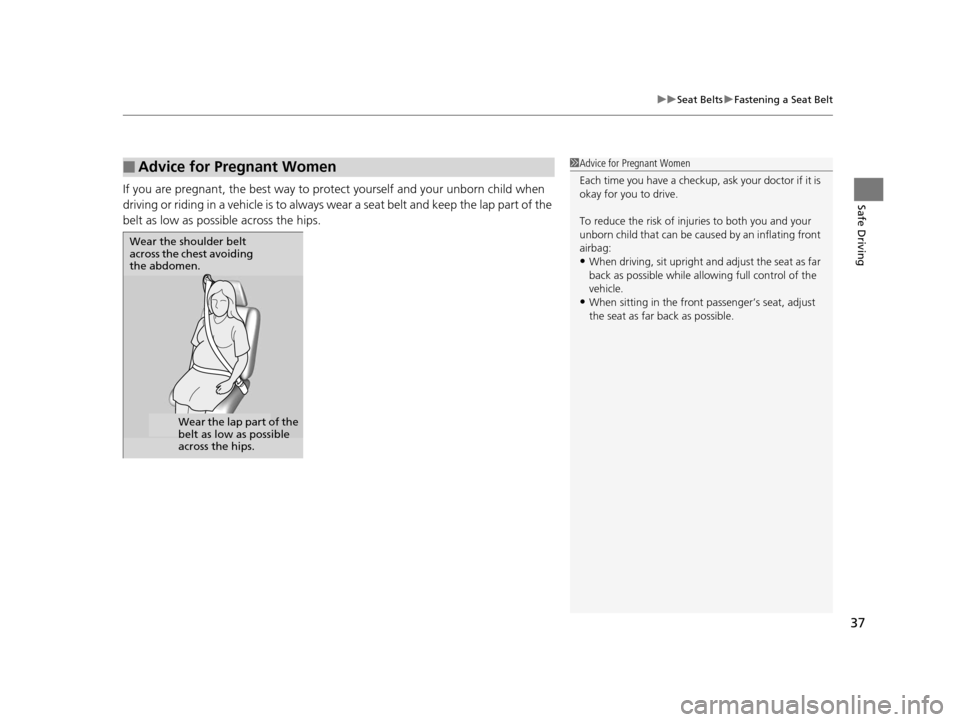
37
uuSeat Belts uFastening a Seat Belt
Safe DrivingIf you are pregnant, the best way to prot ect yourself and your unborn child when
driving or riding in a vehicle is to always wear a seat belt and keep the lap part of the
belt as low as possible across the hips.
■Advice for Pregnant Women1 Advice for Pregnant Women
Each time you have a checkup, ask your doctor if it is
okay for you to drive.
To reduce the risk of inju ries to both you and your
unborn child that can be caus ed by an inflating front
airbag:
•When driving, sit upright a nd adjust the seat as far
back as possible while allowing full control of the
vehicle.
•When sitting in the front passenger’s seat, adjust
the seat as far back as possible.
Wear the shoulder belt
across the chest avoiding
the abdomen.
Wear the lap part of the
belt as low as possible
across the hips.
15 CIVIC IMA-31TR26300.book 37 ページ 2014年9月9日 火曜日 午後12時20分
Page 41 of 377
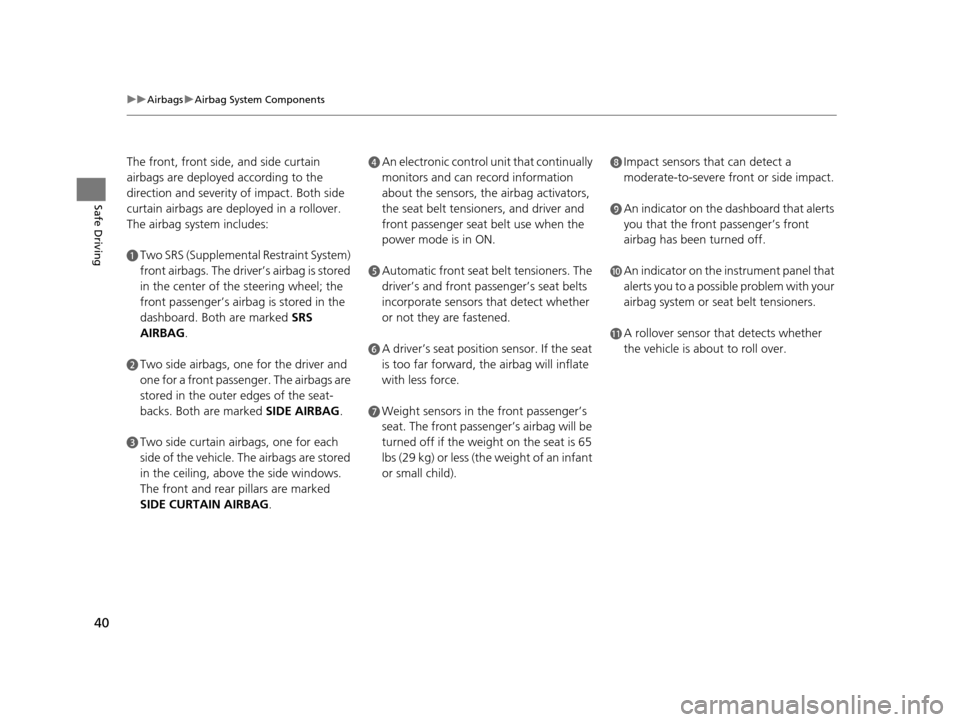
40
uuAirbags uAirbag System Components
Safe Driving
The front, front side, and side curtain
airbags are deployed according to the
direction and severity of impact. Both side
curtain airbags are depl oyed in a rollover.
The airbag system includes:
aTwo SRS (Supplemental Restraint System)
front airbags. The driver’s airbag is stored
in the center of the steering wheel; the
front passenger’s airbag is stored in the
dashboard. Both are marked SRS
AIRBAG.
bTwo side airbags, one for the driver and
one for a front passenger. The airbags are
stored in the outer edges of the seat-
backs. Both are marked SIDE AIRBAG .
cTwo side curtain airbags, one for each
side of the vehicle. The airbags are stored
in the ceiling, above the side windows.
The front and rear pillars are marked
SIDE CURTAIN AIRBAG.
dAn electronic control unit that continually
monitors and can re cord information
about the sensors, the airbag activators,
the seat belt tensioners, and driver and
front passenger seat belt use when the
power mode is in ON.
eAutomatic front seat belt tensioners. The
driver’s and front passenger’s seat belts
incorporate sensors that detect whether
or not they are fastened.
fA driver’s seat position sensor. If the seat
is too far forward, the airbag will inflate
with less force.
gWeight sensors in the front passenger’s
seat. The front passenger’s airbag will be
turned off if the weight on the seat is 65
lbs (29 kg) or less (the weight of an infant
or small child).
hImpact sensors that can detect a
moderate-to-severe front or side impact.
iAn indicator on the dashboard that alerts
you that the front passenger’s front
airbag has been turned off.
jAn indicator on the instrument panel that
alerts you to a possible problem with your
airbag system or seat belt tensioners.
kA rollover sensor that detects whether
the vehicle is about to roll over.
15 CIVIC IMA-31TR26300.book 40 ページ 2014年9月9日 火曜日 午後12時20分